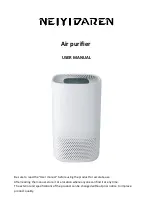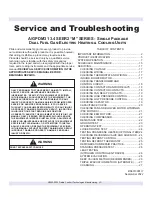
26-EN
25-EN
– 13 –
* In case of
fl
aring with the conventional
fl
are tool,
pull it out approx. 0.5 mm more than that for R22
to djust to the speci
fi
ed
fl
are size. The copper pipe
gauge is useful for adjusting projection margin size.
• The sealed gas was sealed at the atmospheric
pressure so when the
fl
are nut is removed, there
will no “whooshing” sound: This is normal and is not
indicative of trouble.
• Use two wrenches to connect the indoor unit pipe.
Work using double spanner
y
Use the tightening torque levels as listed in the
following table.
Outer dia. of
connecting pipe (mm)
Tightening torque (N•m)
6.4
14 to 18 (1.4 to 1.8 kgf•m)
9.5
34 to 42 (3.4 to 4.2 kgf•m)
T
Tightening torque of flare pipe connections
Incorrect connections may cause not only a gas leak,
but also a trouble of the refrigeration cycle.
Align the centres of the connecting pipes and tighten
the
fl
are nut as far as possible with your
fi
ngers.
Then tighten the nut with a spanner and torque wrench
as shown in the
fi
gure.
CAUTION
Tightening with an excessive torque may crack the
nut depending on installation conditions.
Evacuation
Perform vacuuming from the charge port of valve of
the outdoor unit by using a vacuum pump.
For details, follow to the Installation Manual attached
to the outdoor unit.
y
Do not use the refrigerant sealed in the outdoor unit
for evacuation.
REQUIREMENT
For the tools such as charge hose, etc., use those
manufactured exclusively for R32.
Refrigerant amount to be added
For addition of the refrigerant, add refrigerant
“R32” referring to the attached Installation Manual of
outdoor unit.
Use a scale to charge the refrigerant of speci
fi
ed
amount.
REQUIREMENT
y
Charging an excessive or too little amount of
refrigerant causes a trouble of the compressor.
Charge the refrigerant of speci
fi
ed amount.
y
A personnel who charged the refrigerant should
write down the pipe length and the added
refrigerant amount in the F-GAS label of the
outdoor unit. It is necessary to
fi
x the compressor
and refrigeration cycle malfunction.
Open the valve fully
Open the valve of the outdoor unit fully.
A 4 mm-hexagonal wrench is required for opening the
valve.
For details, refer to the Installation Manual attached to
the outdoor unit.
Gas leak check
Check with a leak detector or soap water whether gas
leaks or not, from the pipe connecting section or cap
of the valve.
REQUIREMENT
Use a leak detector manufactured exclusively for
HFC refrigerant (R32, R134a, R410A, etc.).
Heat insulation process
Apply heat insulation for the pipes separately at liquid side and gas side.
y
For the heat insulation to the pipes at gas side, be sure to use the material with heat-resisting temperature
120°C or higher.
y
To use the attached heat insulation pipe, apply the heat insulation to the pipe connecting section of the
indoor unit securely without gap.
REQUIREMENT
y
Apply the heat insulation to the pipe connecting section of the indoor unit securely up to the root without
exposure of the pipe. (The pipe exposed to the outside causes water leak.)
y
Wrap heat insulator with its slits facing up (ceiling side).
Indoor unit
The seam must be faced upward
(ceiling side).
Wrap the pipe with the attached heat
insulator without any gap between the
indoor unit.
Flare nut
Heat insulator
of the pipe
Banding band
(Locally procured)
Union
Heat insulation
pipe (Accessory)















































